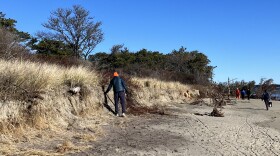Connecticut is home to dozens of destination-worthy museums showcasing everything from classical artwork, history and the law, to trolleys, radios, puppets and so much more.
Douglas P. Clement is a regular contributor to Connecticut Magazine and former senior editor. He recently wrote a piece for Connecticut Magazine on the state's vast and diverse collection of museums and talked with Morning Edition’s Lori Mack.
Lori Mack: Can you talk about some of the museums that you think might surprise people?
Douglas P. Clement: Of course, a couple that really impressed me are the Submarine Force Museum in Groton, and the Hill-Stead Museum in Farmington. Two completely different things. The Submarine Force Museum is actually on the sub base in Groton, so it's a hidden gem, literally, physically, you have to kind of pass a checkpoint to get in. Once you get to the museum. The exhibits are done super professionally. And then you get to go and walk through the USS Nautilus submarine, which was the nation's first nuclear powered submarine, and made history by going under the North Pole in the late 1950s. You're in the submarine and you quite don't believe it's real, that both you get to do it, and that this is what it was like, you know, the history of the development of submarines in the nation. It's super tight and compact, not like in the movies. And you're surprised that this actually all worked. And you know, feel kind of blessed that you got to see it.

At the Hill-Stead museum, it's a house museum filled with worldclass artwork that people don't really know and find because it's hidden in plain sight, in a way, off Route 4 in Farmington. But among the paintings are French impressionist paintings that include two Monet grainstack paintings. And each of those, in the estimation of the executive director, is better than a grainstack, or Haystack painting, by Monet that set an auction record of over $110 million a few years ago. So, you can walk into this museum and in one room in two paintings, you're looking at almost $250 million worth of artwork.
Mack: Let's highlight some of the more popular museums and what they have to offer, because I think we forget about those, and a lot of them are in New Haven, right?
Clement: You know, New Haven has been getting a lot of buzz lately as a worldclass international destination. And a lot of it is for the museums. And of course, most of those are centered at Yale. So, the Yale Center for British Art and the Yale University Art Gallery are both truly amazing museums. The collections are phenomenal, unbelievable. And the Beinecke Library at Yale is another, you know, of their gems. And they have some really offbeat museums at Yale too including the Cushing Museum, which everybody knows for its collection of human brains that are displayed in, you know, jars full of liquid.
I've spent most of my time in the art museums. And at the art gallery, you'll find things like Van Gogh's famous painting The Night Café, you know, one of the world's most recognized most iconic paintings. And it's free, always free. And you know, what I like about those museums, as well as the offbeat hidden gems that we cover in Connecticut Magazine, is to try to make them the centerpiece of a real lifestyle experience. So, in New Haven, that's easy, you know, I'm talking about wonderful cafes and coffee places, and lunch and shopping. And, you know, I think you can do that with anything that we have in this feature, even the lesser known ones. And one I would highlight for that in particular is the Tapping Reeve House and Litchfield Law School in Litchfield. It's an amazing little place. And it really is an undiscovered gem. So, in the center of Litchfield, which is a historic town, pre-Colonial Era town, big role in the Revolutionary War. George Washington’s spymaster Benjamin Tallmadge lived on North Street in Litchfield after the Revolutionary War. The old jail, built in 1812 to house prisoners in the War of 1812, is now a restaurant, a bakery and a gourmet shop. So, there's the Litchfield Historical Society, which has a great collection and has an exhibit, which I think is still up, called Painting Litchfield of all the local artwork. And down the street is the Tapping Reeve House where Judge Tapping Reeve lived. He founded the Litchfield Law School, it's next door. Both of them are open as museums. And it's the oldest law school in the country. It educated something like two or three vice presidents, a whole bunch of senators, more than 100 congressmen, and you go there and you see how the very first legal education happened, as well as the Sarah Pierce Academy for female students, which opened in 1792, I think. That's also on display. And it's super cool.

And beyond that they have created in the back now what's called the Tapping Reeve Meadow. And there's a very beautiful Arbor and chairs and a trail and gardens. And on the Fourth of July, they're going to do a pet parade, which they do every year. So everybody brings their dogs, bunnies, cats, they dress them up for the Fourth of July, and they parade through the meadow. It's really a hometown thing. Both those museums and the Historical Society, they're right in the center of town. So, you're talking like an absolute lifestyle haven for like, fine dining, coffee, shopping. A complete day trip and it’s all right there.
This interview has been edited.





